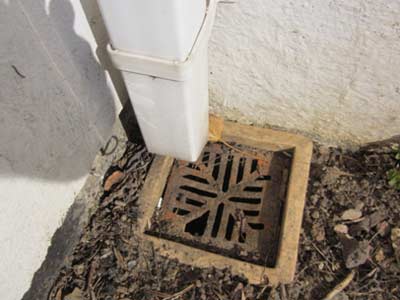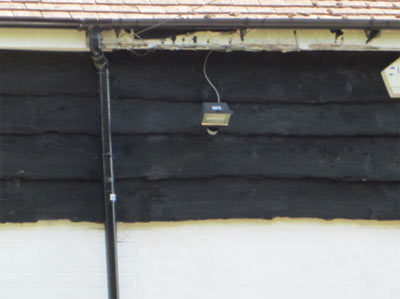
Surface Water Drain and Down Pipe
Types Of Drainage System
Rainwater, surface water and runoff, should never be discharged into a cesspool or septic tank.
Many people don’t realise that where they have mains drainage they most likely have two systems, one for foul water which takes waste water from toilets, bathrooms, kitchens, and washing machines so it can be treated in sewage plants before retuning it safely to the water system.
The other domestic water system takes away rainwater and runoff from roofs and gutters, driveway drains, French drains and pond overflows. This is returned to watercourses untreated, so you should always be very careful before connecting anything to a drain.
Foul water drainage should only be discharged into the correct foul drainage system and it must never be discharged into a French drain or soakaway. If you allow foul water into the rainwater drains there is a danger of pollution of rivers and even drinking water
You should also be careful to dispose of chemicals or oils properly and not allow them to be poured into a drainage system, because you could be introducing sewage or chemicals directly into rivers, causing damage to the eco system and poisoning wildlife.
For more information on the journey of our water and how water and sewage is treated you can read this interesting online pamphlet from Water UK.
Connecting to Existing Drainage Systems
If you are planning works that are going to connect to an existing drainage system you need to make sure you do things properly to avoid these issues.
If you are going to add an appliance drainage pipe, fit a new bathroom, cloakroom or toilet, or build a French drain you should make sure you comply with building regulations. You can contact your local council or look at the .Gov website to find out the process for applying for Building Regulations approval.
You also need to know if you have a dual or combined drainage system. Combined drainage systems carry away foul and surface water in one set of pipework. Dual drainage systems have separate foul and surface water pipes.
If you have a dual drainage system, then you need to be sure which system you are going to add your drainage to – so how do you know what you have got, and which drainage system is which?
Surface Water Systems
Surface Water comes from:
- Rainwater Goods (roofs, gutters and downpipes)
- Garden, Driveway or Road drains or gullies
- Linear drains

Surface Water Drains from Roofs into Downpipes and into the Drainage System
Foul Water Systems
Foul water sources include:
- Kitchen waste pipes
- Toilet or Soil and Vent Pipe
- Basin waste pipes
- Bath, Shower and Bidet waste pipes
- Any commercial or industrial processes
Identifying Your Drainage System
Property Age
If you property is newer than 1970, then it is most likely that you will have a dual drainage system.
Manholes
If you seem to have double the manholes (they may even be side by side) then it is likely you have a dual drainage system.
Lift the Covers
If you lift the covers on manholes to reveal the inspection chambers you may see that one system is higher than the other – this indicates a dual system because foul water drains should always be laid lower than the surface water system to prevent contamination (in case of leaks or damage to the foul water pipework).
If you lift the manhole covers and you can see sewage then you have located the foul or combined drainage. (You may be able to see toilet tissue or even, erm solid matter.)
Run the Water
Get a companion to flush the toilet, or run the washing machine, and watch where the water runs within the drains to locate the foul water drainage.
Garden Hose Method
Try running a hose down a downpipe to check for surface water drains.
Traceable Dye
If you are really struggling to identify which system you have you can purchase a drain-tracing dye which will not contaminate the water, but will help you to identify the flow of water in your drains. Ask at the builders merchants, and explain what you want it for.
- If you have a combined system, the dyed test water show up in the chamber from both foul and surface sources.
- If you have opened a surface only drain, the dyed test water will only show up when the dye is added to a surface drainage point.
- If you have opened a foul only drain, the dyed test water will show up if you flush the toilet when dye has been added to the pan or cistern.
Existing Soakaways
If you have an existing soakaway that is not working properly or not able to cope with the amount of water you want to add to it then you should build a new soakaway. Make sure you site it well away from the existing one (at least 20m away).
If building a new soakaway is not possible, then you may need to renovate the existing system. This could involve digging out the old pit and replacing the graded stones, if it is just silted up, or you may need to make the pit bigger to cope with a higher volume of surface water.
For more information on how soakaways work and how to build one, visit our soakaways project.

